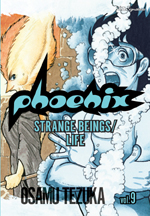 By Osamu Tezuka
By Osamu Tezuka
256 pages, black and white
Published by Viz
Strange Beings/Life is one of the final volumes in Osamu Tezuka’s Phoenix saga, a series spanning over 3000 years of history, alternating stories set in the past and the future. The two stories in this book at a glance seem united only by the inclusion of the being known as the Phoenix, but a closer investigation proves otherwise. Strange Beings/Life shows Tezuka not only creating an uncanny prediction of the 21st century, but a larger statement on the nature of humanity in general, one that connects both of these stories together quite neatly. Some things, be it in our distant past or near future, apparently never change.
In Strange Beings, it is 1498 AD and Sakon Suke is a warrior on an important mission—to slay the priestess who claims she can cure the dread warlord of the neighboring lands, Sakon Suke’s father. But will her mission mark her as doomed as the warlord she wishes dead? In Life, it’s 2155 AD and Aoi has come up with an idea to raise flagging television ratings, a new show where human clones are hunted down on live broadcast. With human clones still illegal, though, Aoi goes to a disturbing place to find what he desires. The process, though, is going to teach Aoi just what he’s willing to put others through when he experiences the terror first hand.
It’s easy to view Strange Beings as little more than a Twilight Zone-esque story involving an enigmatic woman and her killer. On that level alone it succeeds—it’s a succinct story that uses its 114 pages perfectly, needing no more or less to get its smartly-crafted mystery across to the reader. At its core, though, is a Buddhist parable about atonement, forgiveness, and the never-ending wheel of life. When viewed that way, Tezuka has created a story that both inspires fear and hope. He’s able to bring across Sakon Suke’s despair when she realizes the nature of her predicament, and her panic and terror make her almost sympathetic in that moment, despite the fact that her punishment more than suits her crime. As Sakon Suke serves out her sentence, though, and becomes more humble as she begins her transformation, the story’s tone shifts from fear to hope. Even though Sakon Suke’s fate is insinuated to be an unavoidable cycle that she can’t escape, she’s still able to rise above her past and become a better person. At the end of Strange Beings, you’re able to truly understand the peace that Sakon Suke has learned for herself.
The second story, Life, takes a broader look at ideas first broached in Strange Beings, mapping them onto an entire society instead of a single person. This is a world that relishes in a television show where people die each week, after all, humanity clamoring to see the clones die. Created long before the “reality television” explosion, Tezuka’s vision of a world willing to throw away lives for a cheap thrill is a bleak one. It’s apt, then, that Life is the story in this volume where the Phoenix has a more central role. While Strange Beings had the Phoenix as little more than a messenger, Life uses it as catalyst, catapulting Aoi into his own personal transformation. This is the person who is at the center of the cancerous growth in humanity, the one who first envisioned the televised clone massacres. His slow rehabilitation asks the question that if he can be saved, what about the rest of humanity? Like Strange Beings, Life has both fear and hope, but here the hope has to do with the entire world possibly getting better instead of just our protagonist. Lest you think that Tezuka is focusing entirely on spiritual questions, though, there’s also a mix of elements in Life that include action-adventure, espionage, and weird science focused on ancient Incan ruins. Tezuka clearly understood the need to get his message to the public in a form that they’d listen, and if that meant using genre trappings, he didn’t have a problem with that.
Tezuka’s art is as always a joy to read. It’s crisp and uncluttered, almost as if you’re reading a primer on proper comic storytelling. Panels flow into each other easily, and while there is a simple nature to his art, he’s still able to create imaginative creatures in Phoenix, like the titular Strange Beings that flock en masse to the ancient temple for healing, or the human/Phoenix hybrid in Peru that manages to look both alien and familiar. In the case of Tezuka, less is clearly more.
Phoenix was one of Tezuka’s masterworks, shifting back and forth from one end of a timeline to the other, each installment getting closer towards a central point of convergence that was unfortunately never reached before his death. In an afterward, Tezuka stated, “Each story would stand on its own and seem to have nothing to do with the other stories, but the final story would tie everything together—and for the first time, the reader would realize that the structure of the series is such that each story would be just one part of a much larger story.” In Strange Beings/Life you can clearly see this taking shape, with Tezuka’s fears and hopes for humanity on display moving both directions through time. Which emotion was the more accurate one for where humanity is now? It’s hard to say. If Tezuka’s Phoenix has anything to say about it, though, we still have hope. If you’ve never read any of his Phoenix books, this is a fantastic place to begin Phoenix is one of the great comic book works of the 20th century, and once you’ve read even a small piece of its epic you’ll understand why. Highly recommended.
Purchase Links:
